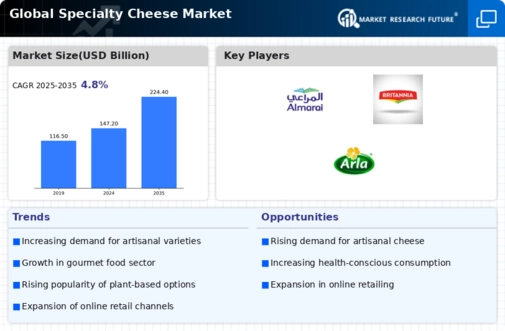Market Share
Specialty Cheese Market Share Analysis
In the dynamic and diverse Specialty Cheese Market, companies employ a range of market share positioning strategies to distinguish themselves in a landscape shaped by evolving consumer tastes and culinary trends. With an increasing demand for unique and high-quality cheese varieties, the specialty cheese segment has become a focal point within the broader dairy market. To establish and enhance their market share, companies strategically approach product development, pricing, distribution, marketing, and innovation. Product differentiation is a fundamental strategy in the Specialty Cheese Market. Companies invest in research and development to create unique and artisanal cheese offerings that stand out in terms of flavors, textures, and production methods. This may involve incorporating distinctive ingredients, such as herbs or spices, or exploring traditional cheese-making techniques. By offering a diverse and high-quality range of specialty cheeses, companies aim to capture the attention of consumers seeking refined and adventurous culinary experiences. Pricing strategies play a crucial role in market share positioning. Some companies adopt a premium pricing approach, targeting consumers willing to pay more for specialty cheeses that emphasize superior quality, craftsmanship, and unique flavor profiles. This strategy is often suitable for artisanal and small-batch producers. On the other hand, competitive pricing may be employed for more widely available specialty cheeses, aiming to capture a larger market share by providing accessible options to a broad consumer base.
Distribution channels are significant factors in market share positioning within the Specialty Cheese Market. Establishing strong relationships with specialty food retailers, upscale supermarkets, restaurants, and online platforms ensures widespread availability of specialty cheese products. Exclusive partnerships with key players in the food and hospitality industry can provide a competitive advantage, securing prominent shelf space and visibility for specific specialty cheese brands. Marketing and branding initiatives play a pivotal role in creating a strong market presence. Companies invest in building brand identities that convey the craftsmanship, heritage, and unique characteristics of their specialty cheeses. Marketing campaigns that highlight the versatility of specialty cheeses in gourmet cooking, cheese pairings, and charcuterie boards can resonate with consumers. Effective use of digital marketing, social media, and collaborations with culinary influencers or chefs contribute to increased brand awareness, establishing credibility and, subsequently, market share. Innovation in flavors, aging techniques, and packaging is another key strategy for market share positioning. Companies explore new and exotic flavor profiles, experiment with longer aging processes, and introduce innovative packaging formats to enhance the consumer experience. Innovations that align with current culinary trends, such as plant-based or lactose-free options, can set a company apart in the market and contribute to increased market share. Collaborations and partnerships within the industry are strategic moves to strengthen market share in the Specialty Cheese Market. Companies may collaborate with renowned chefs, cheese experts, or local producers to co-create unique cheese varieties or limited-edition releases. Additionally, partnerships with specialty food festivals, wine tastings, or culinary events can lead to exclusive product showcases or promotions, enhancing a brand's visibility and market share. Continuous monitoring of consumer trends is essential for adapting market share positioning strategies. The Specialty Cheese Market is influenced by evolving culinary preferences, global flavors, and a growing interest in artisanal and locally sourced products. Companies that stay attuned to these changes can adjust their strategies accordingly, ensuring that their specialty cheese offerings remain relevant and appealing to a diverse consumer base.







Leave a Comment